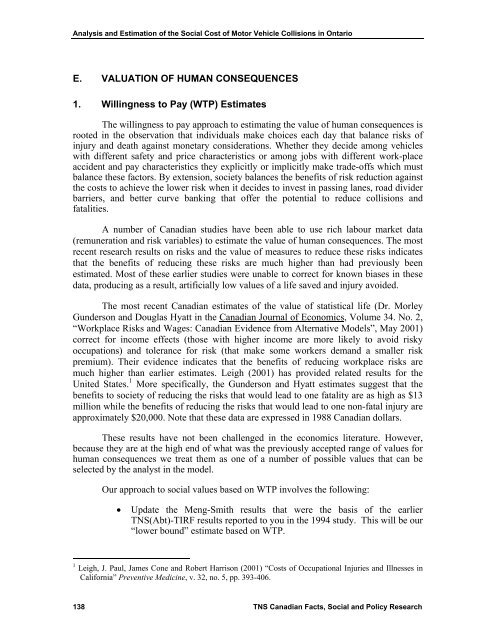Keith Vodden Dr. Douglas Smith - Transports Canada
Keith Vodden Dr. Douglas Smith - Transports Canada
Keith Vodden Dr. Douglas Smith - Transports Canada
You also want an ePaper? Increase the reach of your titles
YUMPU automatically turns print PDFs into web optimized ePapers that Google loves.
Analysis and Estimation of the Social Cost of Motor Vehicle Collisions in Ontario<br />
E. VALUATION OF HUMAN CONSEQUENCES<br />
1. Willingness to Pay (WTP) Estimates<br />
The willingness to pay approach to estimating the value of human consequences is<br />
rooted in the observation that individuals make choices each day that balance risks of<br />
injury and death against monetary considerations. Whether they decide among vehicles<br />
with different safety and price characteristics or among jobs with different work-place<br />
accident and pay characteristics they explicitly or implicitly make trade-offs which must<br />
balance these factors. By extension, society balances the benefits of risk reduction against<br />
the costs to achieve the lower risk when it decides to invest in passing lanes, road divider<br />
barriers, and better curve banking that offer the potential to reduce collisions and<br />
fatalities.<br />
A number of Canadian studies have been able to use rich labour market data<br />
(remuneration and risk variables) to estimate the value of human consequences. The most<br />
recent research results on risks and the value of measures to reduce these risks indicates<br />
that the benefits of reducing these risks are much higher than had previously been<br />
estimated. Most of these earlier studies were unable to correct for known biases in these<br />
data, producing as a result, artificially low values of a life saved and injury avoided.<br />
The most recent Canadian estimates of the value of statistical life (<strong>Dr</strong>. Morley<br />
Gunderson and <strong>Douglas</strong> Hyatt in the Canadian Journal of Economics, Volume 34. No. 2,<br />
“Workplace Risks and Wages: Canadian Evidence from Alternative Models”, May 2001)<br />
correct for income effects (those with higher income are more likely to avoid risky<br />
occupations) and tolerance for risk (that make some workers demand a smaller risk<br />
premium). Their evidence indicates that the benefits of reducing workplace risks are<br />
much higher than earlier estimates. Leigh (2001) has provided related results for the<br />
United States. 1 More specifically, the Gunderson and Hyatt estimates suggest that the<br />
benefits to society of reducing the risks that would lead to one fatality are as high as $13<br />
million while the benefits of reducing the risks that would lead to one non-fatal injury are<br />
approximately $20,000. Note that these data are expressed in 1988 Canadian dollars.<br />
These results have not been challenged in the economics literature. However,<br />
because they are at the high end of what was the previously accepted range of values for<br />
human consequences we treat them as one of a number of possible values that can be<br />
selected by the analyst in the model.<br />
Our approach to social values based on WTP involves the following:<br />
• Update the Meng-<strong>Smith</strong> results that were the basis of the earlier<br />
TNS(Abt)-TIRF results reported to you in the 1994 study. This will be our<br />
“lower bound” estimate based on WTP.<br />
1 Leigh, J. Paul, James Cone and Robert Harrison (2001) “Costs of Occupational Injuries and Illnesses in<br />
California” Preventive Medicine, v. 32, no. 5, pp. 393-406.<br />
138 TNS Canadian Facts, Social and Policy Research
















